Gender Inequality and Women in Society: An In-depth Essay
VerifiedAdded on 2022/11/13
|10
|3226
|357
Essay
AI Summary
This essay delves into the multifaceted roles of women in society, focusing on gender inequality, historical perspectives, and the evolution of women in the workplace. It examines the impact of socio-economic factors, cultural norms, and workplace discrimination on women's opportunities and advancement. The essay explores the concept of gender equity, advocating for fair treatment and equal opportunities for women in various aspects of life, including access to work and leadership positions. It highlights the challenges women face, such as wage gaps and underrepresentation in leadership, while also emphasizing the importance of gender mainstreaming and legislative efforts to promote equality. Furthermore, the essay discusses the contributions of women leaders and managers, emphasizing their unique strengths and abilities in organizational settings, including financial management and event planning. Overall, the essay provides a comprehensive analysis of the issues affecting women in society and advocates for greater equity and empowerment.
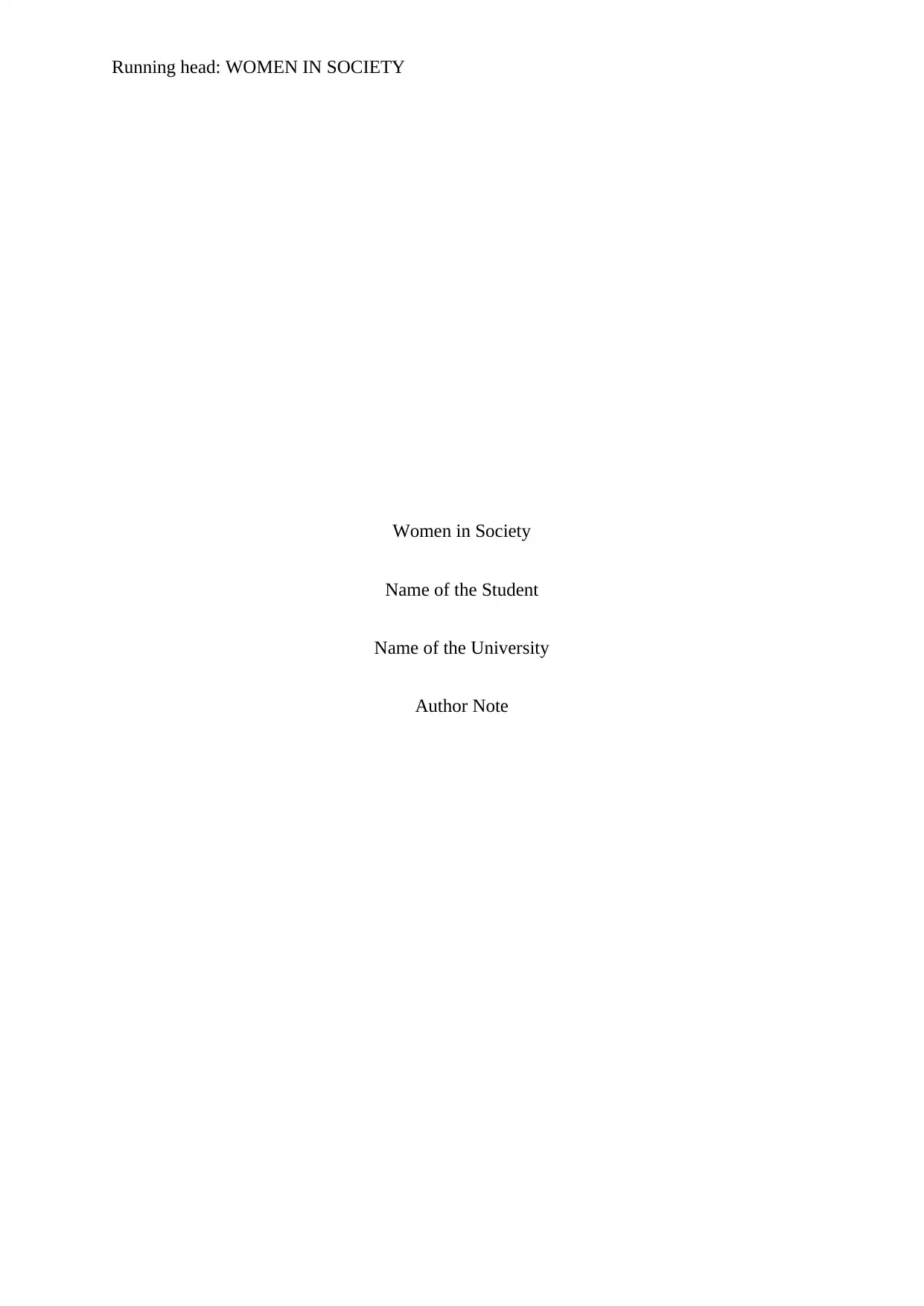
Running head: WOMEN IN SOCIETY
Women in Society
Name of the Student
Name of the University
Author Note
Women in Society
Name of the Student
Name of the University
Author Note
Paraphrase This Document
Need a fresh take? Get an instant paraphrase of this document with our AI Paraphraser
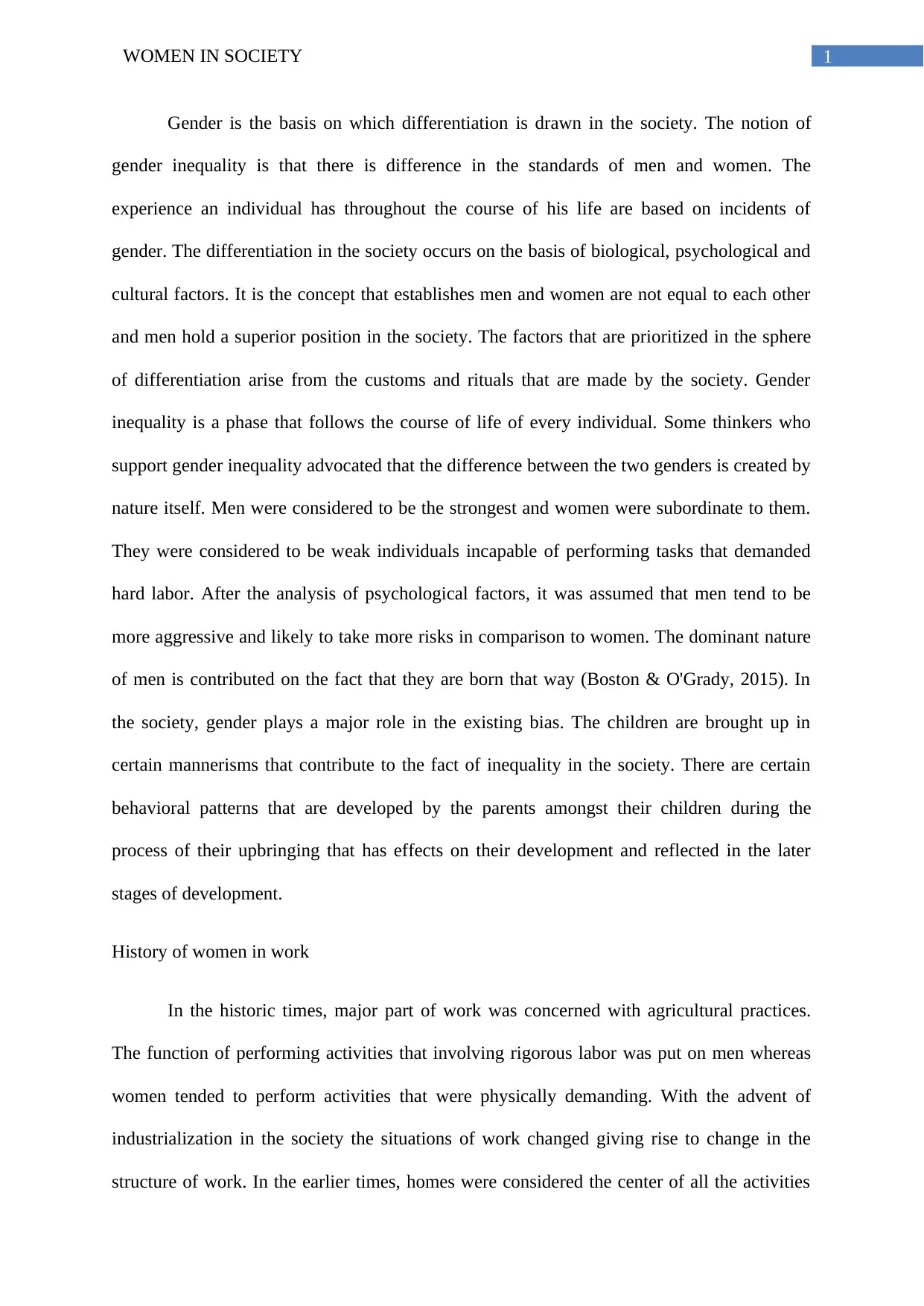
1WOMEN IN SOCIETY
Gender is the basis on which differentiation is drawn in the society. The notion of
gender inequality is that there is difference in the standards of men and women. The
experience an individual has throughout the course of his life are based on incidents of
gender. The differentiation in the society occurs on the basis of biological, psychological and
cultural factors. It is the concept that establishes men and women are not equal to each other
and men hold a superior position in the society. The factors that are prioritized in the sphere
of differentiation arise from the customs and rituals that are made by the society. Gender
inequality is a phase that follows the course of life of every individual. Some thinkers who
support gender inequality advocated that the difference between the two genders is created by
nature itself. Men were considered to be the strongest and women were subordinate to them.
They were considered to be weak individuals incapable of performing tasks that demanded
hard labor. After the analysis of psychological factors, it was assumed that men tend to be
more aggressive and likely to take more risks in comparison to women. The dominant nature
of men is contributed on the fact that they are born that way (Boston & O'Grady, 2015). In
the society, gender plays a major role in the existing bias. The children are brought up in
certain mannerisms that contribute to the fact of inequality in the society. There are certain
behavioral patterns that are developed by the parents amongst their children during the
process of their upbringing that has effects on their development and reflected in the later
stages of development.
History of women in work
In the historic times, major part of work was concerned with agricultural practices.
The function of performing activities that involving rigorous labor was put on men whereas
women tended to perform activities that were physically demanding. With the advent of
industrialization in the society the situations of work changed giving rise to change in the
structure of work. In the earlier times, homes were considered the center of all the activities
Gender is the basis on which differentiation is drawn in the society. The notion of
gender inequality is that there is difference in the standards of men and women. The
experience an individual has throughout the course of his life are based on incidents of
gender. The differentiation in the society occurs on the basis of biological, psychological and
cultural factors. It is the concept that establishes men and women are not equal to each other
and men hold a superior position in the society. The factors that are prioritized in the sphere
of differentiation arise from the customs and rituals that are made by the society. Gender
inequality is a phase that follows the course of life of every individual. Some thinkers who
support gender inequality advocated that the difference between the two genders is created by
nature itself. Men were considered to be the strongest and women were subordinate to them.
They were considered to be weak individuals incapable of performing tasks that demanded
hard labor. After the analysis of psychological factors, it was assumed that men tend to be
more aggressive and likely to take more risks in comparison to women. The dominant nature
of men is contributed on the fact that they are born that way (Boston & O'Grady, 2015). In
the society, gender plays a major role in the existing bias. The children are brought up in
certain mannerisms that contribute to the fact of inequality in the society. There are certain
behavioral patterns that are developed by the parents amongst their children during the
process of their upbringing that has effects on their development and reflected in the later
stages of development.
History of women in work
In the historic times, major part of work was concerned with agricultural practices.
The function of performing activities that involving rigorous labor was put on men whereas
women tended to perform activities that were physically demanding. With the advent of
industrialization in the society the situations of work changed giving rise to change in the
structure of work. In the earlier times, homes were considered the center of all the activities
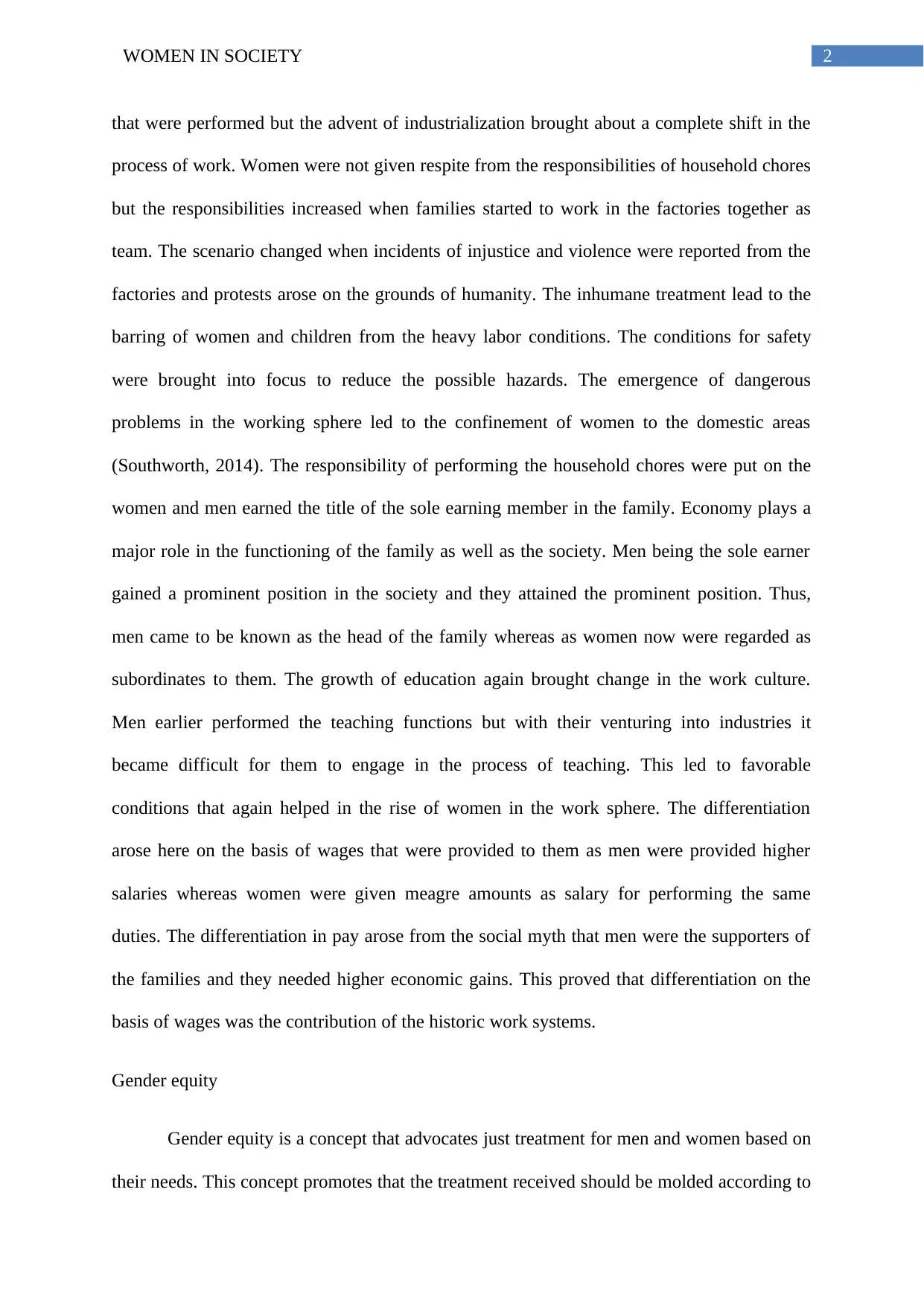
2WOMEN IN SOCIETY
that were performed but the advent of industrialization brought about a complete shift in the
process of work. Women were not given respite from the responsibilities of household chores
but the responsibilities increased when families started to work in the factories together as
team. The scenario changed when incidents of injustice and violence were reported from the
factories and protests arose on the grounds of humanity. The inhumane treatment lead to the
barring of women and children from the heavy labor conditions. The conditions for safety
were brought into focus to reduce the possible hazards. The emergence of dangerous
problems in the working sphere led to the confinement of women to the domestic areas
(Southworth, 2014). The responsibility of performing the household chores were put on the
women and men earned the title of the sole earning member in the family. Economy plays a
major role in the functioning of the family as well as the society. Men being the sole earner
gained a prominent position in the society and they attained the prominent position. Thus,
men came to be known as the head of the family whereas as women now were regarded as
subordinates to them. The growth of education again brought change in the work culture.
Men earlier performed the teaching functions but with their venturing into industries it
became difficult for them to engage in the process of teaching. This led to favorable
conditions that again helped in the rise of women in the work sphere. The differentiation
arose here on the basis of wages that were provided to them as men were provided higher
salaries whereas women were given meagre amounts as salary for performing the same
duties. The differentiation in pay arose from the social myth that men were the supporters of
the families and they needed higher economic gains. This proved that differentiation on the
basis of wages was the contribution of the historic work systems.
Gender equity
Gender equity is a concept that advocates just treatment for men and women based on
their needs. This concept promotes that the treatment received should be molded according to
that were performed but the advent of industrialization brought about a complete shift in the
process of work. Women were not given respite from the responsibilities of household chores
but the responsibilities increased when families started to work in the factories together as
team. The scenario changed when incidents of injustice and violence were reported from the
factories and protests arose on the grounds of humanity. The inhumane treatment lead to the
barring of women and children from the heavy labor conditions. The conditions for safety
were brought into focus to reduce the possible hazards. The emergence of dangerous
problems in the working sphere led to the confinement of women to the domestic areas
(Southworth, 2014). The responsibility of performing the household chores were put on the
women and men earned the title of the sole earning member in the family. Economy plays a
major role in the functioning of the family as well as the society. Men being the sole earner
gained a prominent position in the society and they attained the prominent position. Thus,
men came to be known as the head of the family whereas as women now were regarded as
subordinates to them. The growth of education again brought change in the work culture.
Men earlier performed the teaching functions but with their venturing into industries it
became difficult for them to engage in the process of teaching. This led to favorable
conditions that again helped in the rise of women in the work sphere. The differentiation
arose here on the basis of wages that were provided to them as men were provided higher
salaries whereas women were given meagre amounts as salary for performing the same
duties. The differentiation in pay arose from the social myth that men were the supporters of
the families and they needed higher economic gains. This proved that differentiation on the
basis of wages was the contribution of the historic work systems.
Gender equity
Gender equity is a concept that advocates just treatment for men and women based on
their needs. This concept promotes that the treatment received should be molded according to
⊘ This is a preview!⊘
Do you want full access?
Subscribe today to unlock all pages.

Trusted by 1+ million students worldwide
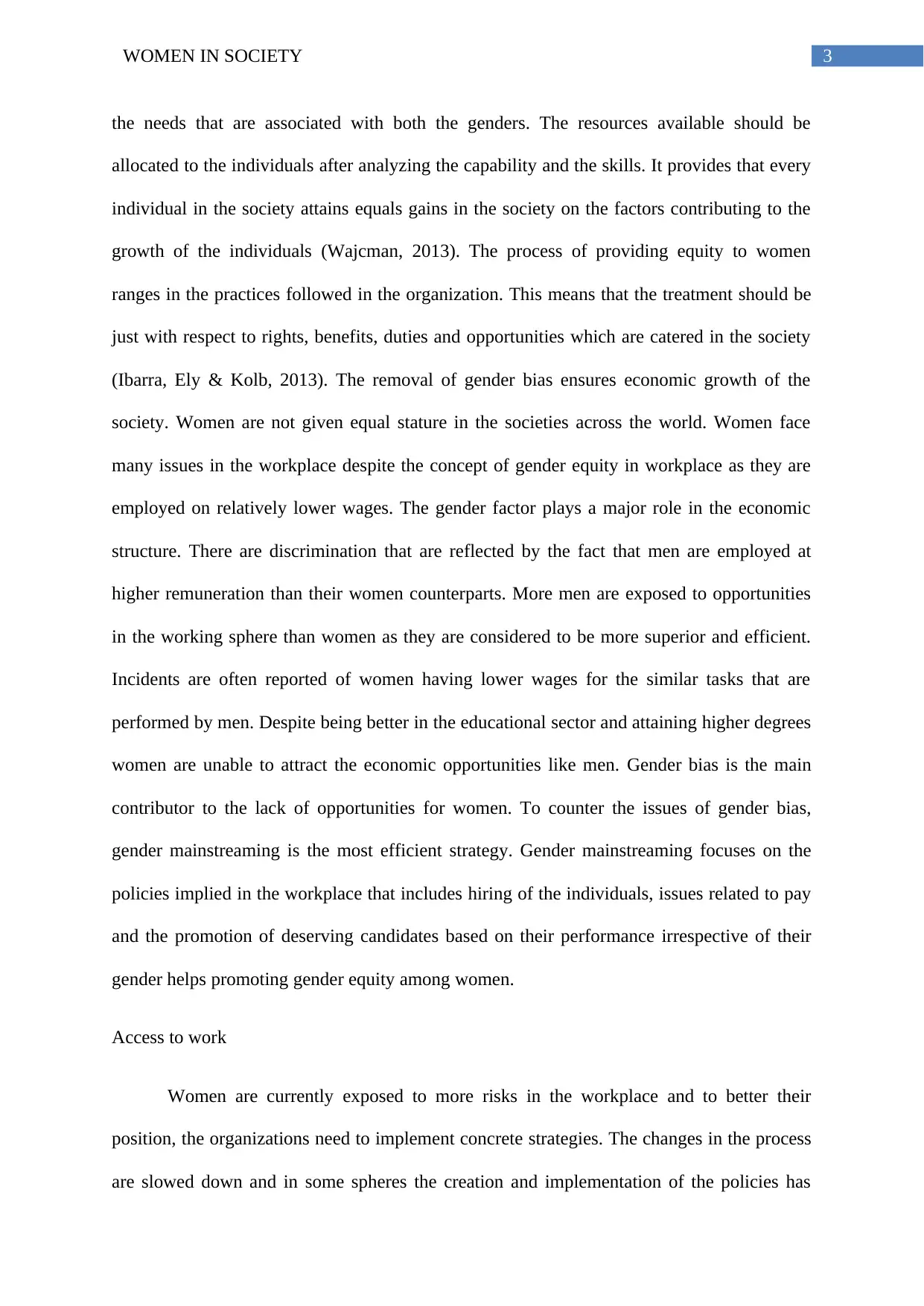
3WOMEN IN SOCIETY
the needs that are associated with both the genders. The resources available should be
allocated to the individuals after analyzing the capability and the skills. It provides that every
individual in the society attains equals gains in the society on the factors contributing to the
growth of the individuals (Wajcman, 2013). The process of providing equity to women
ranges in the practices followed in the organization. This means that the treatment should be
just with respect to rights, benefits, duties and opportunities which are catered in the society
(Ibarra, Ely & Kolb, 2013). The removal of gender bias ensures economic growth of the
society. Women are not given equal stature in the societies across the world. Women face
many issues in the workplace despite the concept of gender equity in workplace as they are
employed on relatively lower wages. The gender factor plays a major role in the economic
structure. There are discrimination that are reflected by the fact that men are employed at
higher remuneration than their women counterparts. More men are exposed to opportunities
in the working sphere than women as they are considered to be more superior and efficient.
Incidents are often reported of women having lower wages for the similar tasks that are
performed by men. Despite being better in the educational sector and attaining higher degrees
women are unable to attract the economic opportunities like men. Gender bias is the main
contributor to the lack of opportunities for women. To counter the issues of gender bias,
gender mainstreaming is the most efficient strategy. Gender mainstreaming focuses on the
policies implied in the workplace that includes hiring of the individuals, issues related to pay
and the promotion of deserving candidates based on their performance irrespective of their
gender helps promoting gender equity among women.
Access to work
Women are currently exposed to more risks in the workplace and to better their
position, the organizations need to implement concrete strategies. The changes in the process
are slowed down and in some spheres the creation and implementation of the policies has
the needs that are associated with both the genders. The resources available should be
allocated to the individuals after analyzing the capability and the skills. It provides that every
individual in the society attains equals gains in the society on the factors contributing to the
growth of the individuals (Wajcman, 2013). The process of providing equity to women
ranges in the practices followed in the organization. This means that the treatment should be
just with respect to rights, benefits, duties and opportunities which are catered in the society
(Ibarra, Ely & Kolb, 2013). The removal of gender bias ensures economic growth of the
society. Women are not given equal stature in the societies across the world. Women face
many issues in the workplace despite the concept of gender equity in workplace as they are
employed on relatively lower wages. The gender factor plays a major role in the economic
structure. There are discrimination that are reflected by the fact that men are employed at
higher remuneration than their women counterparts. More men are exposed to opportunities
in the working sphere than women as they are considered to be more superior and efficient.
Incidents are often reported of women having lower wages for the similar tasks that are
performed by men. Despite being better in the educational sector and attaining higher degrees
women are unable to attract the economic opportunities like men. Gender bias is the main
contributor to the lack of opportunities for women. To counter the issues of gender bias,
gender mainstreaming is the most efficient strategy. Gender mainstreaming focuses on the
policies implied in the workplace that includes hiring of the individuals, issues related to pay
and the promotion of deserving candidates based on their performance irrespective of their
gender helps promoting gender equity among women.
Access to work
Women are currently exposed to more risks in the workplace and to better their
position, the organizations need to implement concrete strategies. The changes in the process
are slowed down and in some spheres the creation and implementation of the policies has
Paraphrase This Document
Need a fresh take? Get an instant paraphrase of this document with our AI Paraphraser
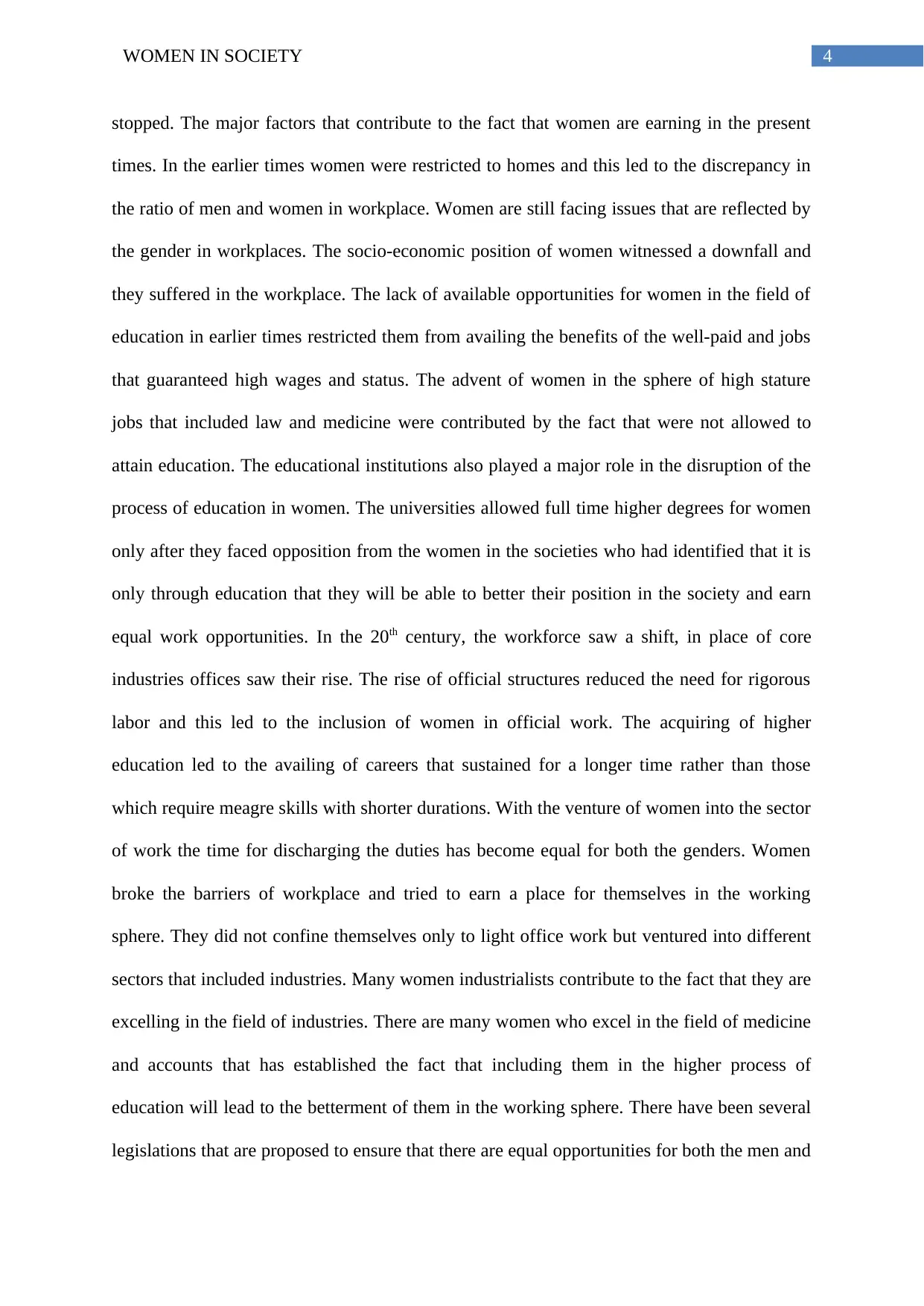
4WOMEN IN SOCIETY
stopped. The major factors that contribute to the fact that women are earning in the present
times. In the earlier times women were restricted to homes and this led to the discrepancy in
the ratio of men and women in workplace. Women are still facing issues that are reflected by
the gender in workplaces. The socio-economic position of women witnessed a downfall and
they suffered in the workplace. The lack of available opportunities for women in the field of
education in earlier times restricted them from availing the benefits of the well-paid and jobs
that guaranteed high wages and status. The advent of women in the sphere of high stature
jobs that included law and medicine were contributed by the fact that were not allowed to
attain education. The educational institutions also played a major role in the disruption of the
process of education in women. The universities allowed full time higher degrees for women
only after they faced opposition from the women in the societies who had identified that it is
only through education that they will be able to better their position in the society and earn
equal work opportunities. In the 20th century, the workforce saw a shift, in place of core
industries offices saw their rise. The rise of official structures reduced the need for rigorous
labor and this led to the inclusion of women in official work. The acquiring of higher
education led to the availing of careers that sustained for a longer time rather than those
which require meagre skills with shorter durations. With the venture of women into the sector
of work the time for discharging the duties has become equal for both the genders. Women
broke the barriers of workplace and tried to earn a place for themselves in the working
sphere. They did not confine themselves only to light office work but ventured into different
sectors that included industries. Many women industrialists contribute to the fact that they are
excelling in the field of industries. There are many women who excel in the field of medicine
and accounts that has established the fact that including them in the higher process of
education will lead to the betterment of them in the working sphere. There have been several
legislations that are proposed to ensure that there are equal opportunities for both the men and
stopped. The major factors that contribute to the fact that women are earning in the present
times. In the earlier times women were restricted to homes and this led to the discrepancy in
the ratio of men and women in workplace. Women are still facing issues that are reflected by
the gender in workplaces. The socio-economic position of women witnessed a downfall and
they suffered in the workplace. The lack of available opportunities for women in the field of
education in earlier times restricted them from availing the benefits of the well-paid and jobs
that guaranteed high wages and status. The advent of women in the sphere of high stature
jobs that included law and medicine were contributed by the fact that were not allowed to
attain education. The educational institutions also played a major role in the disruption of the
process of education in women. The universities allowed full time higher degrees for women
only after they faced opposition from the women in the societies who had identified that it is
only through education that they will be able to better their position in the society and earn
equal work opportunities. In the 20th century, the workforce saw a shift, in place of core
industries offices saw their rise. The rise of official structures reduced the need for rigorous
labor and this led to the inclusion of women in official work. The acquiring of higher
education led to the availing of careers that sustained for a longer time rather than those
which require meagre skills with shorter durations. With the venture of women into the sector
of work the time for discharging the duties has become equal for both the genders. Women
broke the barriers of workplace and tried to earn a place for themselves in the working
sphere. They did not confine themselves only to light office work but ventured into different
sectors that included industries. Many women industrialists contribute to the fact that they are
excelling in the field of industries. There are many women who excel in the field of medicine
and accounts that has established the fact that including them in the higher process of
education will lead to the betterment of them in the working sphere. There have been several
legislations that are proposed to ensure that there are equal opportunities for both the men and
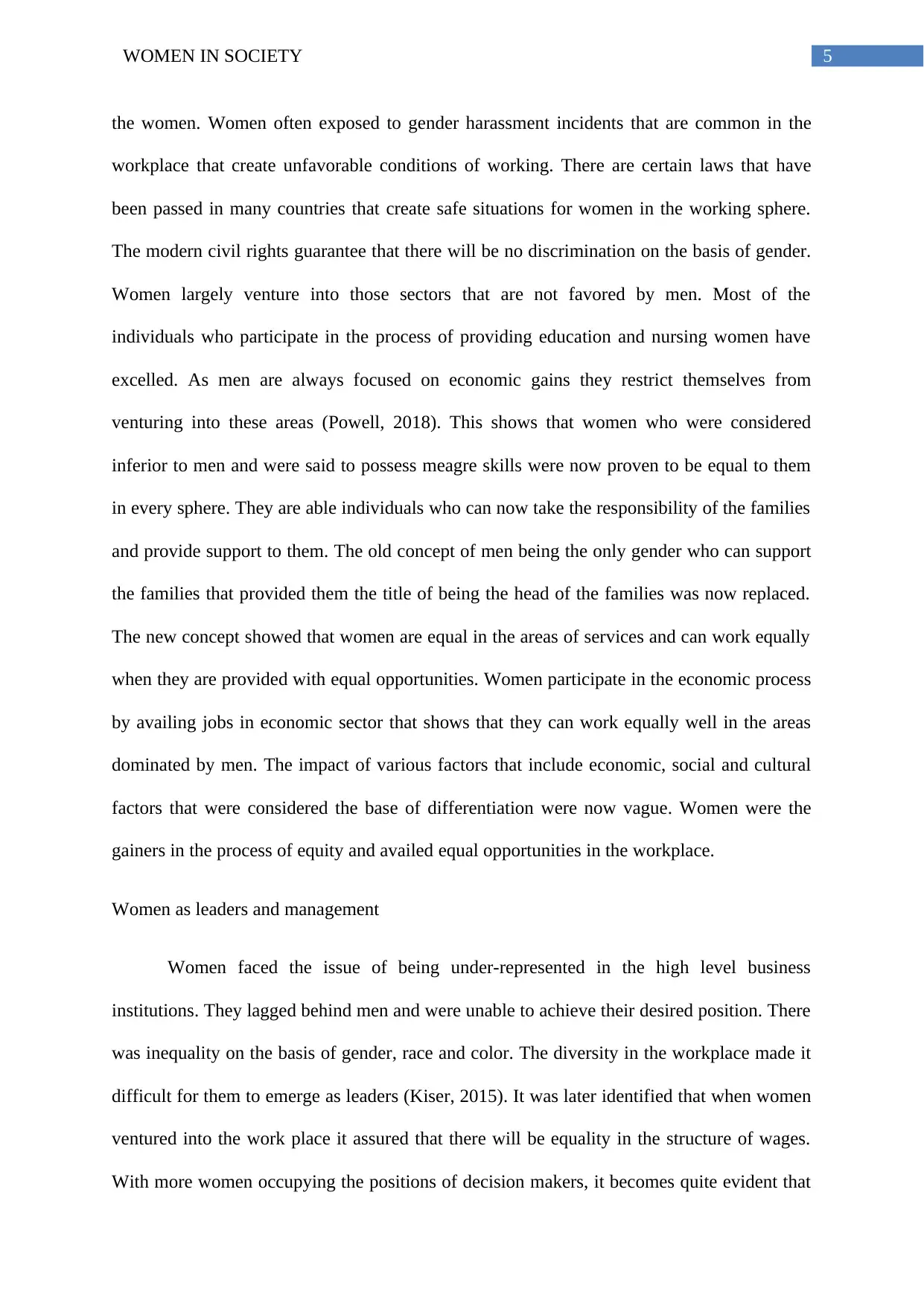
5WOMEN IN SOCIETY
the women. Women often exposed to gender harassment incidents that are common in the
workplace that create unfavorable conditions of working. There are certain laws that have
been passed in many countries that create safe situations for women in the working sphere.
The modern civil rights guarantee that there will be no discrimination on the basis of gender.
Women largely venture into those sectors that are not favored by men. Most of the
individuals who participate in the process of providing education and nursing women have
excelled. As men are always focused on economic gains they restrict themselves from
venturing into these areas (Powell, 2018). This shows that women who were considered
inferior to men and were said to possess meagre skills were now proven to be equal to them
in every sphere. They are able individuals who can now take the responsibility of the families
and provide support to them. The old concept of men being the only gender who can support
the families that provided them the title of being the head of the families was now replaced.
The new concept showed that women are equal in the areas of services and can work equally
when they are provided with equal opportunities. Women participate in the economic process
by availing jobs in economic sector that shows that they can work equally well in the areas
dominated by men. The impact of various factors that include economic, social and cultural
factors that were considered the base of differentiation were now vague. Women were the
gainers in the process of equity and availed equal opportunities in the workplace.
Women as leaders and management
Women faced the issue of being under-represented in the high level business
institutions. They lagged behind men and were unable to achieve their desired position. There
was inequality on the basis of gender, race and color. The diversity in the workplace made it
difficult for them to emerge as leaders (Kiser, 2015). It was later identified that when women
ventured into the work place it assured that there will be equality in the structure of wages.
With more women occupying the positions of decision makers, it becomes quite evident that
the women. Women often exposed to gender harassment incidents that are common in the
workplace that create unfavorable conditions of working. There are certain laws that have
been passed in many countries that create safe situations for women in the working sphere.
The modern civil rights guarantee that there will be no discrimination on the basis of gender.
Women largely venture into those sectors that are not favored by men. Most of the
individuals who participate in the process of providing education and nursing women have
excelled. As men are always focused on economic gains they restrict themselves from
venturing into these areas (Powell, 2018). This shows that women who were considered
inferior to men and were said to possess meagre skills were now proven to be equal to them
in every sphere. They are able individuals who can now take the responsibility of the families
and provide support to them. The old concept of men being the only gender who can support
the families that provided them the title of being the head of the families was now replaced.
The new concept showed that women are equal in the areas of services and can work equally
when they are provided with equal opportunities. Women participate in the economic process
by availing jobs in economic sector that shows that they can work equally well in the areas
dominated by men. The impact of various factors that include economic, social and cultural
factors that were considered the base of differentiation were now vague. Women were the
gainers in the process of equity and availed equal opportunities in the workplace.
Women as leaders and management
Women faced the issue of being under-represented in the high level business
institutions. They lagged behind men and were unable to achieve their desired position. There
was inequality on the basis of gender, race and color. The diversity in the workplace made it
difficult for them to emerge as leaders (Kiser, 2015). It was later identified that when women
ventured into the work place it assured that there will be equality in the structure of wages.
With more women occupying the positions of decision makers, it becomes quite evident that
⊘ This is a preview!⊘
Do you want full access?
Subscribe today to unlock all pages.

Trusted by 1+ million students worldwide
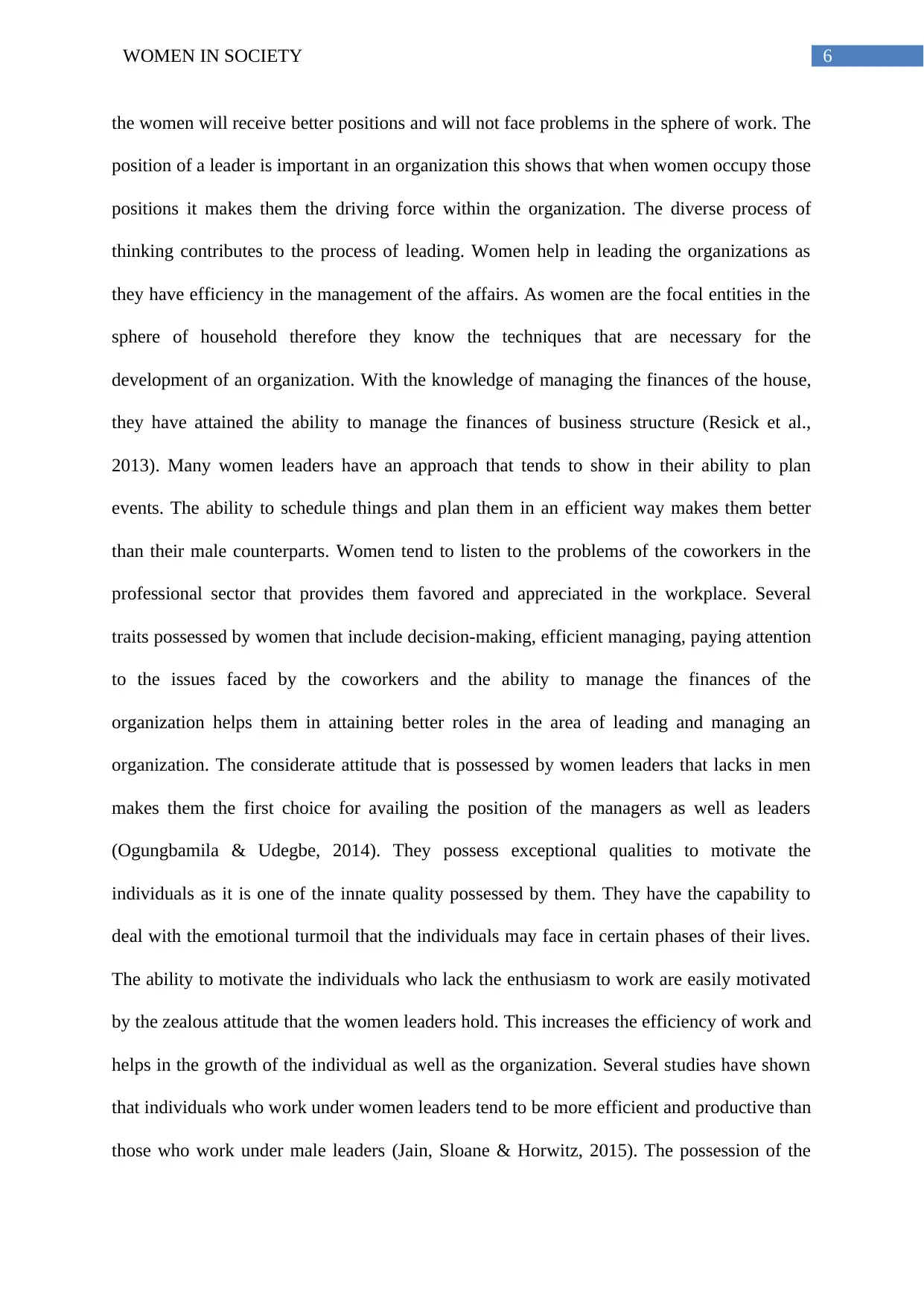
6WOMEN IN SOCIETY
the women will receive better positions and will not face problems in the sphere of work. The
position of a leader is important in an organization this shows that when women occupy those
positions it makes them the driving force within the organization. The diverse process of
thinking contributes to the process of leading. Women help in leading the organizations as
they have efficiency in the management of the affairs. As women are the focal entities in the
sphere of household therefore they know the techniques that are necessary for the
development of an organization. With the knowledge of managing the finances of the house,
they have attained the ability to manage the finances of business structure (Resick et al.,
2013). Many women leaders have an approach that tends to show in their ability to plan
events. The ability to schedule things and plan them in an efficient way makes them better
than their male counterparts. Women tend to listen to the problems of the coworkers in the
professional sector that provides them favored and appreciated in the workplace. Several
traits possessed by women that include decision-making, efficient managing, paying attention
to the issues faced by the coworkers and the ability to manage the finances of the
organization helps them in attaining better roles in the area of leading and managing an
organization. The considerate attitude that is possessed by women leaders that lacks in men
makes them the first choice for availing the position of the managers as well as leaders
(Ogungbamila & Udegbe, 2014). They possess exceptional qualities to motivate the
individuals as it is one of the innate quality possessed by them. They have the capability to
deal with the emotional turmoil that the individuals may face in certain phases of their lives.
The ability to motivate the individuals who lack the enthusiasm to work are easily motivated
by the zealous attitude that the women leaders hold. This increases the efficiency of work and
helps in the growth of the individual as well as the organization. Several studies have shown
that individuals who work under women leaders tend to be more efficient and productive than
those who work under male leaders (Jain, Sloane & Horwitz, 2015). The possession of the
the women will receive better positions and will not face problems in the sphere of work. The
position of a leader is important in an organization this shows that when women occupy those
positions it makes them the driving force within the organization. The diverse process of
thinking contributes to the process of leading. Women help in leading the organizations as
they have efficiency in the management of the affairs. As women are the focal entities in the
sphere of household therefore they know the techniques that are necessary for the
development of an organization. With the knowledge of managing the finances of the house,
they have attained the ability to manage the finances of business structure (Resick et al.,
2013). Many women leaders have an approach that tends to show in their ability to plan
events. The ability to schedule things and plan them in an efficient way makes them better
than their male counterparts. Women tend to listen to the problems of the coworkers in the
professional sector that provides them favored and appreciated in the workplace. Several
traits possessed by women that include decision-making, efficient managing, paying attention
to the issues faced by the coworkers and the ability to manage the finances of the
organization helps them in attaining better roles in the area of leading and managing an
organization. The considerate attitude that is possessed by women leaders that lacks in men
makes them the first choice for availing the position of the managers as well as leaders
(Ogungbamila & Udegbe, 2014). They possess exceptional qualities to motivate the
individuals as it is one of the innate quality possessed by them. They have the capability to
deal with the emotional turmoil that the individuals may face in certain phases of their lives.
The ability to motivate the individuals who lack the enthusiasm to work are easily motivated
by the zealous attitude that the women leaders hold. This increases the efficiency of work and
helps in the growth of the individual as well as the organization. Several studies have shown
that individuals who work under women leaders tend to be more efficient and productive than
those who work under male leaders (Jain, Sloane & Horwitz, 2015). The possession of the
Paraphrase This Document
Need a fresh take? Get an instant paraphrase of this document with our AI Paraphraser
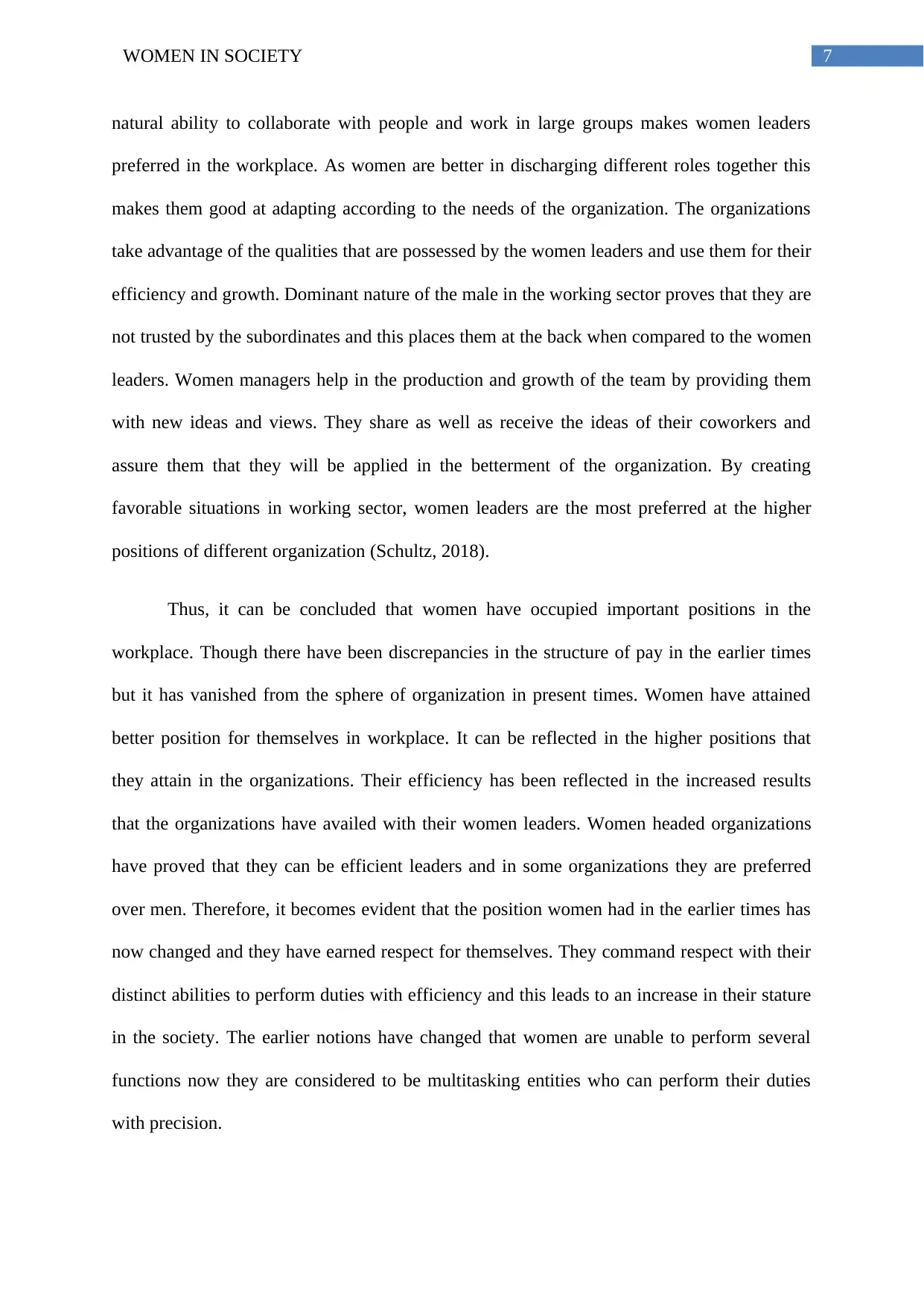
7WOMEN IN SOCIETY
natural ability to collaborate with people and work in large groups makes women leaders
preferred in the workplace. As women are better in discharging different roles together this
makes them good at adapting according to the needs of the organization. The organizations
take advantage of the qualities that are possessed by the women leaders and use them for their
efficiency and growth. Dominant nature of the male in the working sector proves that they are
not trusted by the subordinates and this places them at the back when compared to the women
leaders. Women managers help in the production and growth of the team by providing them
with new ideas and views. They share as well as receive the ideas of their coworkers and
assure them that they will be applied in the betterment of the organization. By creating
favorable situations in working sector, women leaders are the most preferred at the higher
positions of different organization (Schultz, 2018).
Thus, it can be concluded that women have occupied important positions in the
workplace. Though there have been discrepancies in the structure of pay in the earlier times
but it has vanished from the sphere of organization in present times. Women have attained
better position for themselves in workplace. It can be reflected in the higher positions that
they attain in the organizations. Their efficiency has been reflected in the increased results
that the organizations have availed with their women leaders. Women headed organizations
have proved that they can be efficient leaders and in some organizations they are preferred
over men. Therefore, it becomes evident that the position women had in the earlier times has
now changed and they have earned respect for themselves. They command respect with their
distinct abilities to perform duties with efficiency and this leads to an increase in their stature
in the society. The earlier notions have changed that women are unable to perform several
functions now they are considered to be multitasking entities who can perform their duties
with precision.
natural ability to collaborate with people and work in large groups makes women leaders
preferred in the workplace. As women are better in discharging different roles together this
makes them good at adapting according to the needs of the organization. The organizations
take advantage of the qualities that are possessed by the women leaders and use them for their
efficiency and growth. Dominant nature of the male in the working sector proves that they are
not trusted by the subordinates and this places them at the back when compared to the women
leaders. Women managers help in the production and growth of the team by providing them
with new ideas and views. They share as well as receive the ideas of their coworkers and
assure them that they will be applied in the betterment of the organization. By creating
favorable situations in working sector, women leaders are the most preferred at the higher
positions of different organization (Schultz, 2018).
Thus, it can be concluded that women have occupied important positions in the
workplace. Though there have been discrepancies in the structure of pay in the earlier times
but it has vanished from the sphere of organization in present times. Women have attained
better position for themselves in workplace. It can be reflected in the higher positions that
they attain in the organizations. Their efficiency has been reflected in the increased results
that the organizations have availed with their women leaders. Women headed organizations
have proved that they can be efficient leaders and in some organizations they are preferred
over men. Therefore, it becomes evident that the position women had in the earlier times has
now changed and they have earned respect for themselves. They command respect with their
distinct abilities to perform duties with efficiency and this leads to an increase in their stature
in the society. The earlier notions have changed that women are unable to perform several
functions now they are considered to be multitasking entities who can perform their duties
with precision.
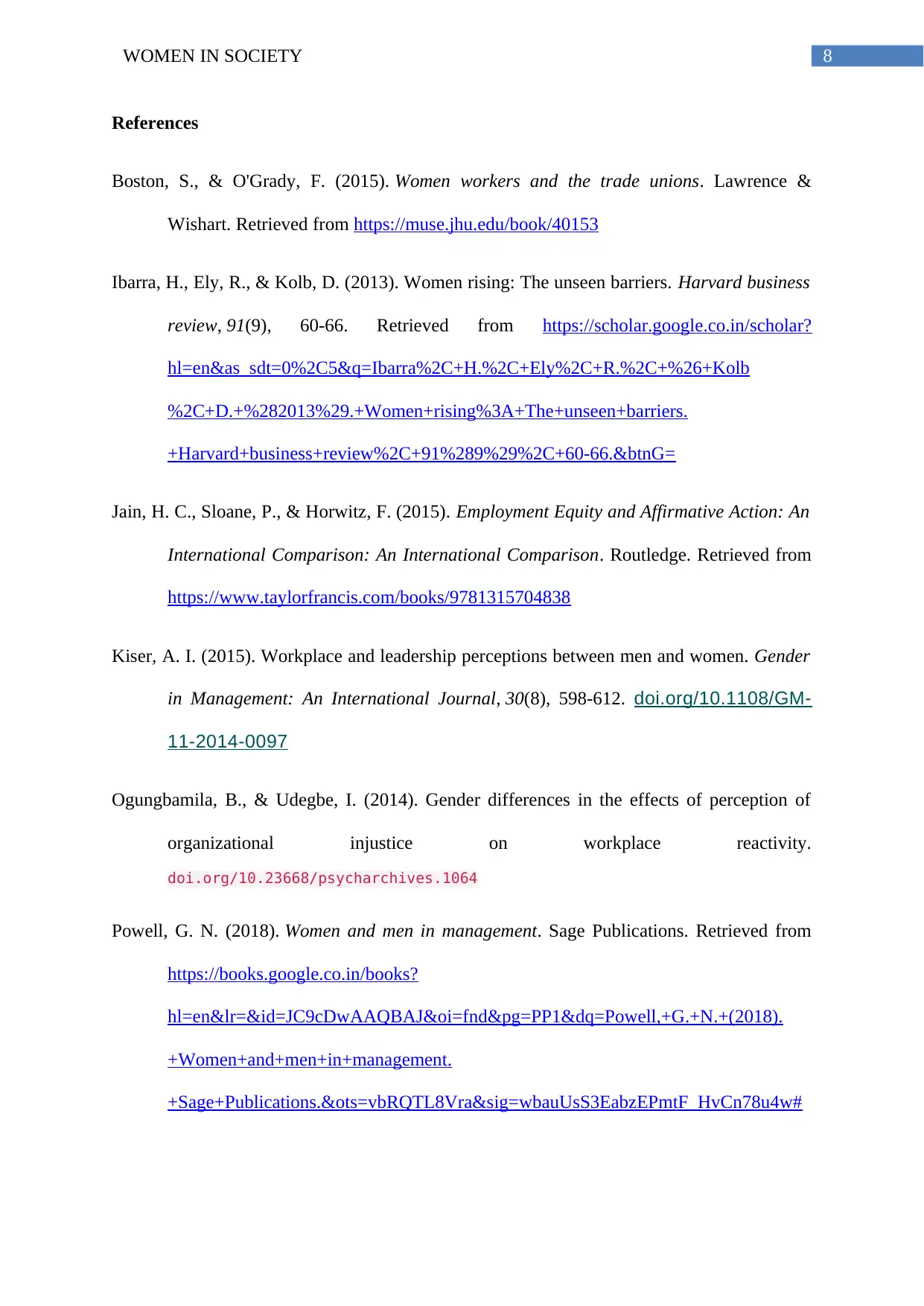
8WOMEN IN SOCIETY
References
Boston, S., & O'Grady, F. (2015). Women workers and the trade unions. Lawrence &
Wishart. Retrieved from https://muse.jhu.edu/book/40153
Ibarra, H., Ely, R., & Kolb, D. (2013). Women rising: The unseen barriers. Harvard business
review, 91(9), 60-66. Retrieved from https://scholar.google.co.in/scholar?
hl=en&as_sdt=0%2C5&q=Ibarra%2C+H.%2C+Ely%2C+R.%2C+%26+Kolb
%2C+D.+%282013%29.+Women+rising%3A+The+unseen+barriers.
+Harvard+business+review%2C+91%289%29%2C+60-66.&btnG=
Jain, H. C., Sloane, P., & Horwitz, F. (2015). Employment Equity and Affirmative Action: An
International Comparison: An International Comparison. Routledge. Retrieved from
https://www.taylorfrancis.com/books/9781315704838
Kiser, A. I. (2015). Workplace and leadership perceptions between men and women. Gender
in Management: An International Journal, 30(8), 598-612. doi.org/10.1108/GM-
11-2014-0097
Ogungbamila, B., & Udegbe, I. (2014). Gender differences in the effects of perception of
organizational injustice on workplace reactivity.
doi.org/10.23668/psycharchives.1064
Powell, G. N. (2018). Women and men in management. Sage Publications. Retrieved from
https://books.google.co.in/books?
hl=en&lr=&id=JC9cDwAAQBAJ&oi=fnd&pg=PP1&dq=Powell,+G.+N.+(2018).
+Women+and+men+in+management.
+Sage+Publications.&ots=vbRQTL8Vra&sig=wbauUsS3EabzEPmtF_HvCn78u4w#
References
Boston, S., & O'Grady, F. (2015). Women workers and the trade unions. Lawrence &
Wishart. Retrieved from https://muse.jhu.edu/book/40153
Ibarra, H., Ely, R., & Kolb, D. (2013). Women rising: The unseen barriers. Harvard business
review, 91(9), 60-66. Retrieved from https://scholar.google.co.in/scholar?
hl=en&as_sdt=0%2C5&q=Ibarra%2C+H.%2C+Ely%2C+R.%2C+%26+Kolb
%2C+D.+%282013%29.+Women+rising%3A+The+unseen+barriers.
+Harvard+business+review%2C+91%289%29%2C+60-66.&btnG=
Jain, H. C., Sloane, P., & Horwitz, F. (2015). Employment Equity and Affirmative Action: An
International Comparison: An International Comparison. Routledge. Retrieved from
https://www.taylorfrancis.com/books/9781315704838
Kiser, A. I. (2015). Workplace and leadership perceptions between men and women. Gender
in Management: An International Journal, 30(8), 598-612. doi.org/10.1108/GM-
11-2014-0097
Ogungbamila, B., & Udegbe, I. (2014). Gender differences in the effects of perception of
organizational injustice on workplace reactivity.
doi.org/10.23668/psycharchives.1064
Powell, G. N. (2018). Women and men in management. Sage Publications. Retrieved from
https://books.google.co.in/books?
hl=en&lr=&id=JC9cDwAAQBAJ&oi=fnd&pg=PP1&dq=Powell,+G.+N.+(2018).
+Women+and+men+in+management.
+Sage+Publications.&ots=vbRQTL8Vra&sig=wbauUsS3EabzEPmtF_HvCn78u4w#
⊘ This is a preview!⊘
Do you want full access?
Subscribe today to unlock all pages.

Trusted by 1+ million students worldwide
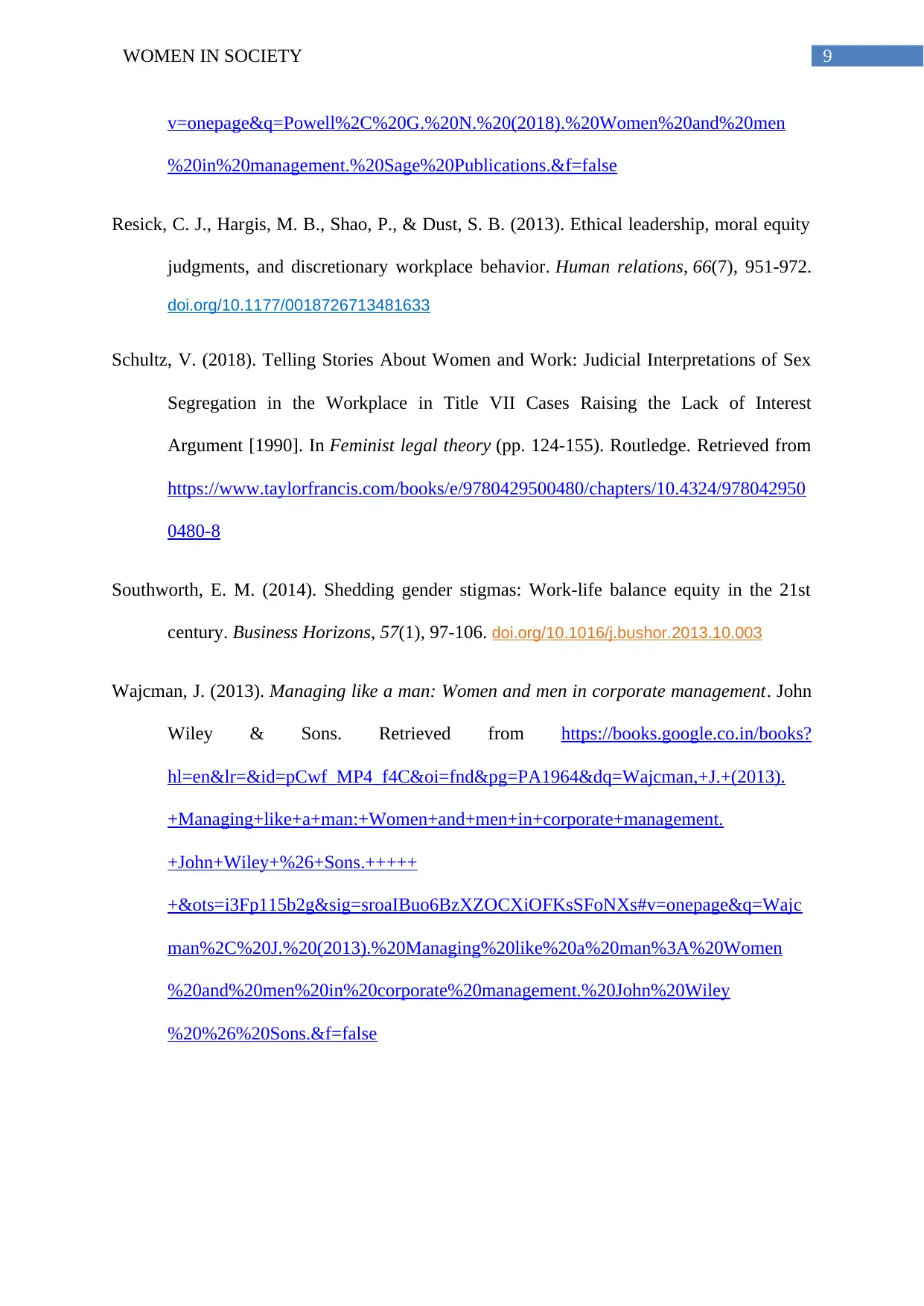
9WOMEN IN SOCIETY
v=onepage&q=Powell%2C%20G.%20N.%20(2018).%20Women%20and%20men
%20in%20management.%20Sage%20Publications.&f=false
Resick, C. J., Hargis, M. B., Shao, P., & Dust, S. B. (2013). Ethical leadership, moral equity
judgments, and discretionary workplace behavior. Human relations, 66(7), 951-972.
doi.org/10.1177/0018726713481633
Schultz, V. (2018). Telling Stories About Women and Work: Judicial Interpretations of Sex
Segregation in the Workplace in Title VII Cases Raising the Lack of Interest
Argument [1990]. In Feminist legal theory (pp. 124-155). Routledge. Retrieved from
https://www.taylorfrancis.com/books/e/9780429500480/chapters/10.4324/978042950
0480-8
Southworth, E. M. (2014). Shedding gender stigmas: Work-life balance equity in the 21st
century. Business Horizons, 57(1), 97-106. doi.org/10.1016/j.bushor.2013.10.003
Wajcman, J. (2013). Managing like a man: Women and men in corporate management. John
Wiley & Sons. Retrieved from https://books.google.co.in/books?
hl=en&lr=&id=pCwf_MP4_f4C&oi=fnd&pg=PA1964&dq=Wajcman,+J.+(2013).
+Managing+like+a+man:+Women+and+men+in+corporate+management.
+John+Wiley+%26+Sons.+++++
+&ots=i3Fp115b2g&sig=sroaIBuo6BzXZOCXiOFKsSFoNXs#v=onepage&q=Wajc
man%2C%20J.%20(2013).%20Managing%20like%20a%20man%3A%20Women
%20and%20men%20in%20corporate%20management.%20John%20Wiley
%20%26%20Sons.&f=false
v=onepage&q=Powell%2C%20G.%20N.%20(2018).%20Women%20and%20men
%20in%20management.%20Sage%20Publications.&f=false
Resick, C. J., Hargis, M. B., Shao, P., & Dust, S. B. (2013). Ethical leadership, moral equity
judgments, and discretionary workplace behavior. Human relations, 66(7), 951-972.
doi.org/10.1177/0018726713481633
Schultz, V. (2018). Telling Stories About Women and Work: Judicial Interpretations of Sex
Segregation in the Workplace in Title VII Cases Raising the Lack of Interest
Argument [1990]. In Feminist legal theory (pp. 124-155). Routledge. Retrieved from
https://www.taylorfrancis.com/books/e/9780429500480/chapters/10.4324/978042950
0480-8
Southworth, E. M. (2014). Shedding gender stigmas: Work-life balance equity in the 21st
century. Business Horizons, 57(1), 97-106. doi.org/10.1016/j.bushor.2013.10.003
Wajcman, J. (2013). Managing like a man: Women and men in corporate management. John
Wiley & Sons. Retrieved from https://books.google.co.in/books?
hl=en&lr=&id=pCwf_MP4_f4C&oi=fnd&pg=PA1964&dq=Wajcman,+J.+(2013).
+Managing+like+a+man:+Women+and+men+in+corporate+management.
+John+Wiley+%26+Sons.+++++
+&ots=i3Fp115b2g&sig=sroaIBuo6BzXZOCXiOFKsSFoNXs#v=onepage&q=Wajc
man%2C%20J.%20(2013).%20Managing%20like%20a%20man%3A%20Women
%20and%20men%20in%20corporate%20management.%20John%20Wiley
%20%26%20Sons.&f=false
1 out of 10
Related Documents
Your All-in-One AI-Powered Toolkit for Academic Success.
+13062052269
info@desklib.com
Available 24*7 on WhatsApp / Email
![[object Object]](/_next/static/media/star-bottom.7253800d.svg)
Unlock your academic potential
Copyright © 2020–2025 A2Z Services. All Rights Reserved. Developed and managed by ZUCOL.





